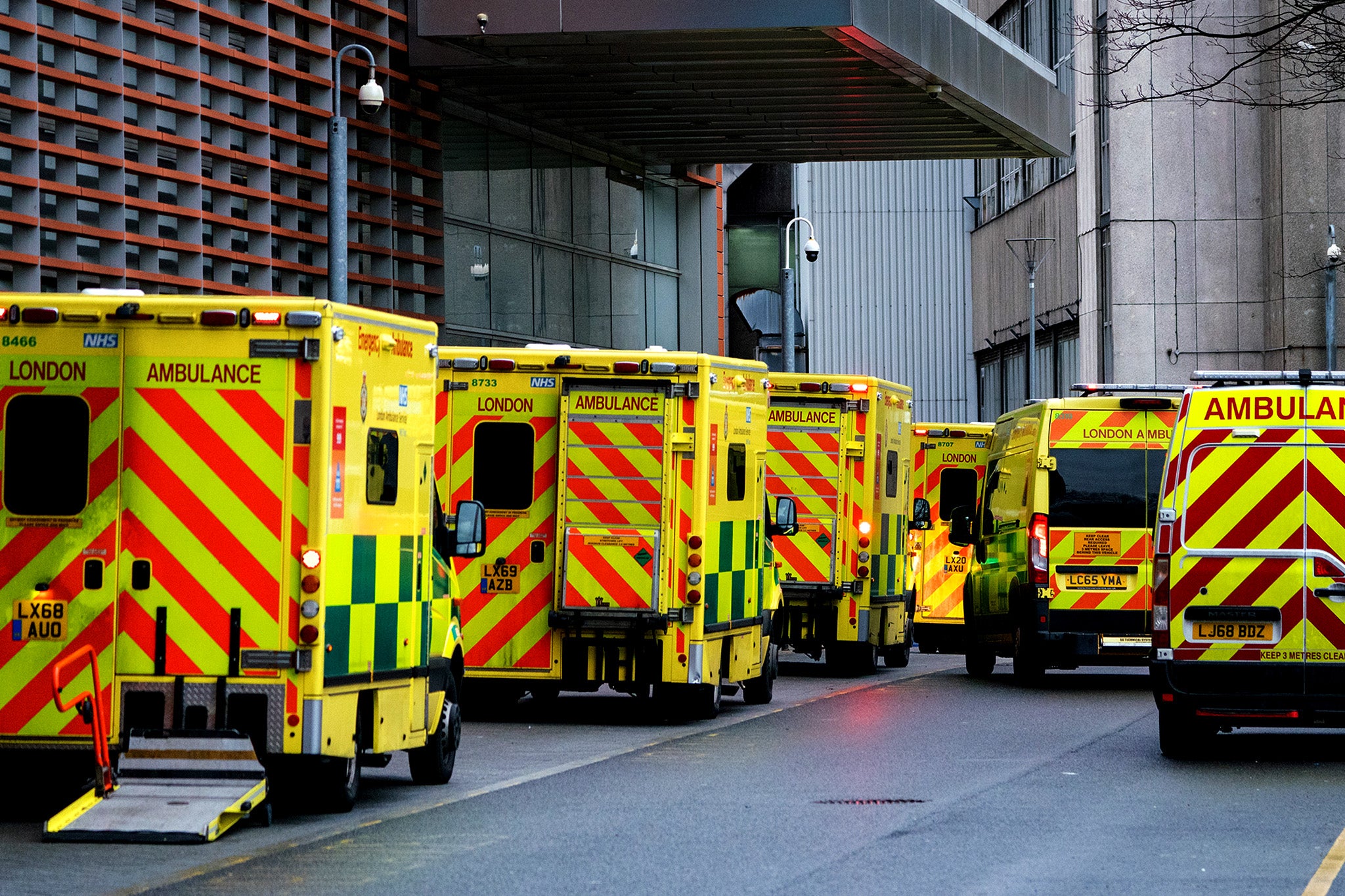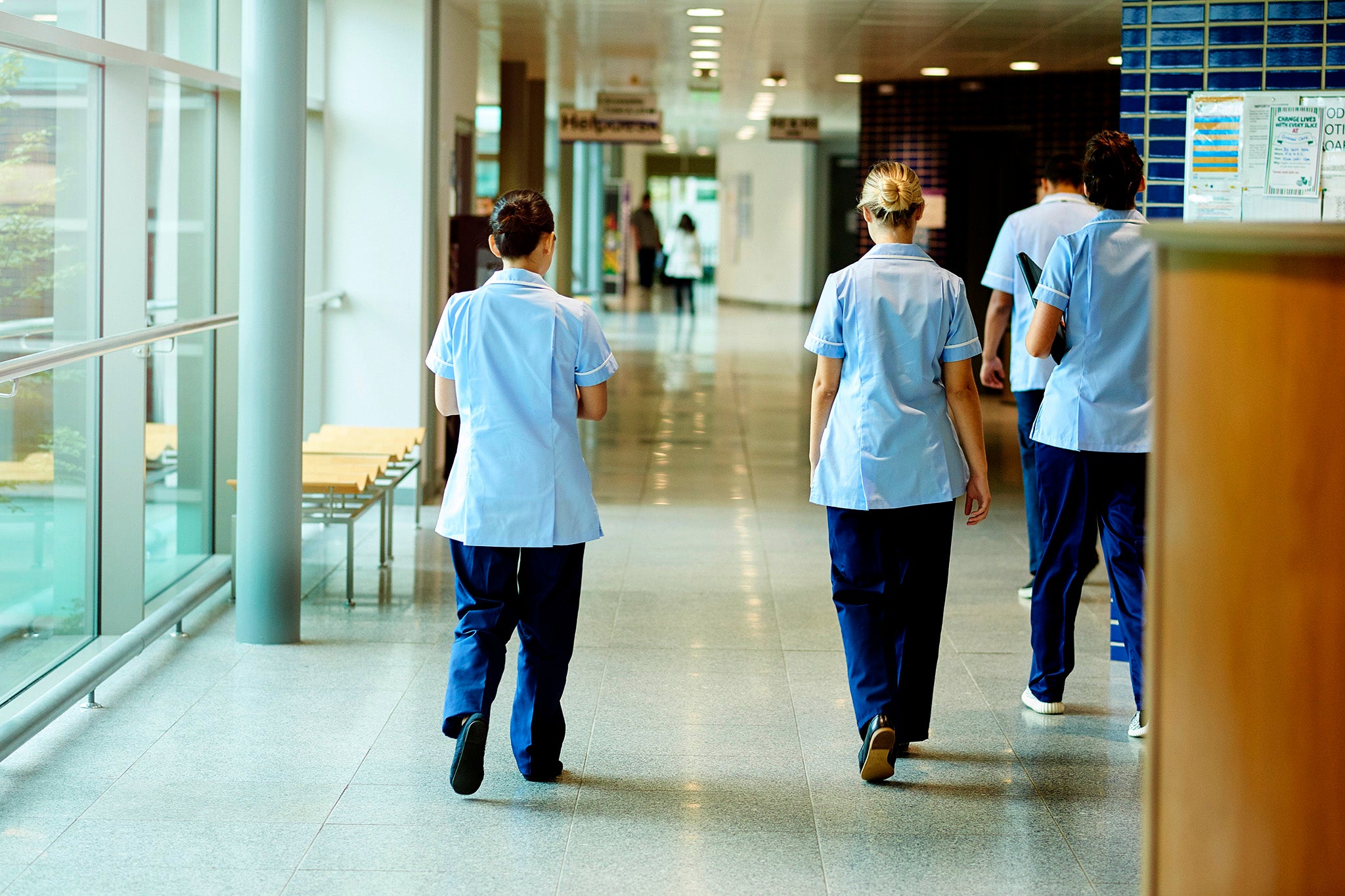
The NHS is under unsustainable pressure at every level, from GP surgeries to emergency wards, as delays to care, soaring demand and a workforce hit by sickness and burnout combine.
As ministers insist Britain must “live with Covid” and move on from the pandemic, on the front line of the health service the strain is greater than during the last wave of coronavirus.
Figures seen by The Independent indicate that the number of patients stuck in hospital beds despite being ready to go home is higher than ever before because of a lack of available care in the community, piling the pressure onto other parts of the system.
A crisis in ambulance services has led to waits as long as two and a half days, while doctors describe patients packed into wards without the resources to take care of them properly.
Ambulance leaders have warned that, by summer, services may be so stretched that they are unable to respond to even the most serious emergencies.
Across the country, NHS staff who have gone above and beyond for two years are still facing intolerable pressure, with no let-up in sight. Calls by NHS leaders to reintroduce masks were rejected by ministers. Andrew Goddard, president of the Royal College of Physicians, said that, while Covid patients themselves are not overwhelming the NHS, they have still accounted for a minimum of 3,650 beds over the past nine months – a need that had not previously existed.
He said: “The pressures on the system at the moment, I think, are unlike anything we've ever seen before, and that is taking its toll.
“Not only are people off sick from Covid at the moment, but we’re now beginning to see people have issues with burnout and mental health problems. I think everybody is worried that the system is beginning to break. It's been unrelenting for over two years now, and the system was hard-pressed before Covid, and it just feels like something bad is going to happen.”
As health leaders warned that patient care had already been compromised, The Independent found:
- Analysis suggests dozens of patients a day are dying because of delays in care
- Stroke victims are waiting six times the recommended amount of time for a paramedic
- Increasing numbers of patients are being forced to make their own way to A&E
- A shortage of beds and staff is causing a crisis from intensive care to mental health
- Hundreds of thousands of patients could be left in limbo waiting for the results of scans
- Nurses are leaving the health service in increasing numbers
Labour condemned the "shocking" findings. Andrew Gwynne, shadow health minister, said: "The Conservative government must explain why standards for patients are being lowered instead of waiting times."
‘It’s full to the rafters’
Hospital chiefs across the country have warned that it is becoming more difficult to move patients out of hospitals and back home, with almost 20,000 patients being stuck on wards for more than three weeks by the end of April, according to internal NHS data.
The domino effect of full beds means longer waits in A&E, as emergency departments cannot admit patients, leaving ambulances to wait hours with patients outside departments. These “handover delays” are in turn keeping ambulances off the road, meaning they cannot get to patients who call 999.
An emergency care consultant in Leeds told The Independent: “It’s full, it’s absolutely full to the rafters, and everyone is just so very tired. Imagine elderly people in beds, rolled up like sardines without enough space to get between the beds, because we don’t have the physical space.”

‘This many 12-hour waits is a catastrophe’
Over the past five months, more patients have been forced to wait 12 hours for care in A&E than in the whole of the previous decade according to public NHS data.
However, leaked data shows the real number waiting over 12 hours is even higher than this as the number has frequently been above 3,000 a day since the start of the year, reaching 3,500 on Wednesday 27 April – equating to one in 20 people who attended emergency departments across the country.
Analysis based on academics’ estimates of the impact of longer waiting times suggests that on Wednesday alone, this could have led to 48 additional deaths.
Dr Steve Black, a data scientist who carried out the analysis earlier this year, said: “The NHS once had less than 2 per cent of A&E patients waiting more than four hours. We know from our work that mortality rises with waits longer than five hours, so this many 12-hour waits is a catastrophe.”
40,000
nursing vacancies across the NHS
Molly Newton took her father Mauris Dodson, 85, to A&E on 15 April after he suffered a fall. They arrived at York Teaching Hospital where he was X-rayed and told to wait in a small room packed with 30 people while a bed was found. “People were lying on the floor, people were bleeding, had drips in their arms,” said Ms Newton. “They’d received treatment, but had nowhere to go: frail, elderly, vulnerable people by themselves. I couldn’t understand how this had gone so badly wrong.”
Hours later, doctors told them to go home and return the next day rather than face an eight-hour wait. After Mr Dodson was sent home, doctors found they had missed a fracture in his pelvis – an intensely painful injury that had left him almost vomiting in pain.
Ms Dodson said: “The frontline staff are doing an incredibly challenging job in the most challenging of times. This is not their fault at all. This a result of systemic and chronic underfunding.”
‘There are patients out there dying’
Clinicians say the biggest threat to safety is the ambulance crisis, with patients having to be turned away by 999 call-handlers. “I fear there are patients out there dying as a consequence of the services failing. It is something that the government has a duty of care to deal with,” said Dr Tom Johnson, a consultant cardiologist in the southwest.
In the southwest of England, ambulances are already on “black alert” – the most serious level – with stroke patients waiting two hours for paramedics to arrive. The recommended response time is 18 minutes for a suspected stroke.
According to internal NHS data, while A&E attendance has remained consistent, the number of patients arriving by ambulance each day in April was 11,500 – 1,000 a day fewer than in February. Sources said the change suggested that more and more people had been forced to make their own way to hospital.

Meanwhile, at the start of April, more than 1,600 ambulances a day were forced to wait more than 60 minutes outside A&E departments to hand over patients.
In the Midlands, one ambulance director said: “April is normally the month where the least hours are lost due to handover delays. This year they’re the highest ever, and so I’m concerned that if the trend continues – we’re currently losing 11 per cent of ambulance hours due to handovers – it could escalate to 30 per cent by August.
“That is where it all falls apart; I predict that that’s the point at which we will be saying to people, ‘I’m sorry, I don’t care what you need.’”
‘Unmanageable workloads’
Intensive care units, hit hardest by the initial waves of Covid, have seen an exodus of staff whose positions they have not been able to fill. Dr Stephen Webb, president of the Intensive Care Society, said departments were “consistently” struggling to meet national standards that require, for example, one doctor for every eight to 12 patients during the day.
He said: “We are definitely seeing a drift away from acute specialties towards less acute specialties, and we’re seeing that up and down the country – that’s being recorded on all our units.”
The crisis goes far beyond emergency care, reaching into every area of the NHS. Dr Julian Elford, a consultant radiologist in Winchester, said patients were unable to get results of scans because of a rise in emergencies and fewer staff. “Nationally, hundreds of thousands of patient scans are waiting,” he said.
This week, NHS figures revealed hundreds of GPs had left their jobs between March 2021 and March 2022, just as the number of appointments hit a record high, while a survey by the Royal College of General Practitioners found that more than half of GP practices had reported losing staff due to “unmanageable workloads”.
I am bewildered why the government would not want to know the facts
The toll of the pandemic on patients is having an impact, too. In January, record levels of mental health referrals for children were recorded, while the CEO of an NHS mental health trust warned that most hospitals were above 100 per cent occupancy, indicating that they had been forced to find makeshift ways to house patients.
A leaked memo seen by The Independent showed that on Thursday 28 April there was just a single bed available for mental health patients in Cornwall.
An ophthalmologist in the West Midlands said that they and their colleagues had seen patients whose conditions had worsened because they had been unable to seek care. “I’ve had patients recently who have come in blind; one patient had not come in because he was scared,” he said. “I saw a man who had a precancerous lesion, which is now a tumour.”

An NHS spokesperson said: “There’s no doubt the last few months have been some of the toughest ever for NHS staff, with a record number of 999 calls over the last year, while more than a tenth of all hospital beds have been filled by people fit to be discharged to services such as social care providers.” But they added that progress had still been made to tackle the backlog in elective treatment.
‘They cannot afford an exodus’
Looking to the future, health leaders warn that the struggle to keep staff means that the road ahead could be even more difficult. Sources warn that internal NHS reports have shown wellbeing levels to be “subterranean in some parts”, with a “marked deterioration” in mental health.
The government faced criticism this week after voting down amendments to its Health and Care Bill that would have required the publication of estimates of future staffing requirements.
Helen Stokes Lampard, president of the Academy of Medical Royal Colleges, said: “I am bewildered why the government would not want to know the facts to enable us all to plan better for the future.”
The Department of Health and Social Care said that staff numbers were at record levels, while investment would also be at record levels over the next three years as it tackled “long-term recovery and reform”. However, while the number of nurses leaving the NHS dropped during the pandemic, The Independent understands that by February the number leaving was back to its pre-pandemic high, with 7 per cent of staff – just over 22,000 – having left in the previous 12 months. Meanwhile, there are still 40,000 nursing vacancies.
Patricia Marquis, director of the Royal College of Nursing, said: “Pressure on health and care services could not be more intense, and patient care is already being compromised. They cannot afford an exodus of experienced nursing staff who felt a duty to help patients at the height of the pandemic. These nurses are fed up with being undervalued by the government, and exhausted from covering tens of thousands of longstanding nursing vacancies.”







